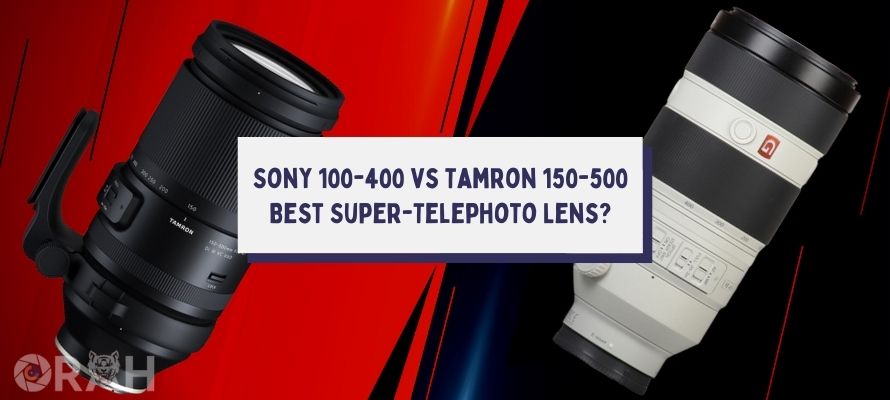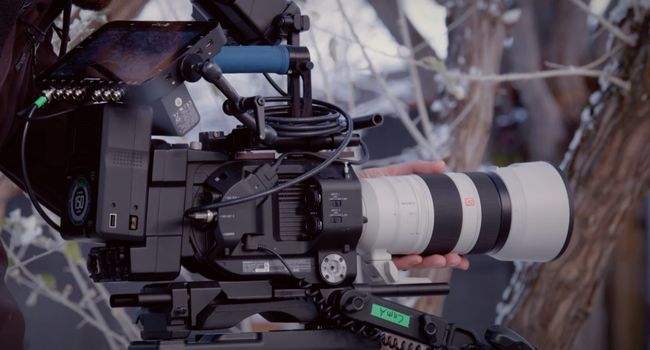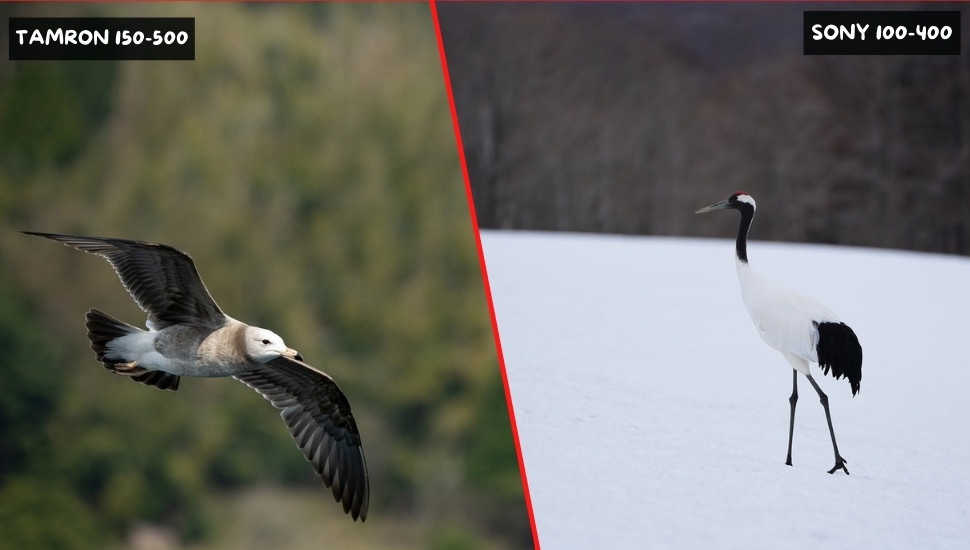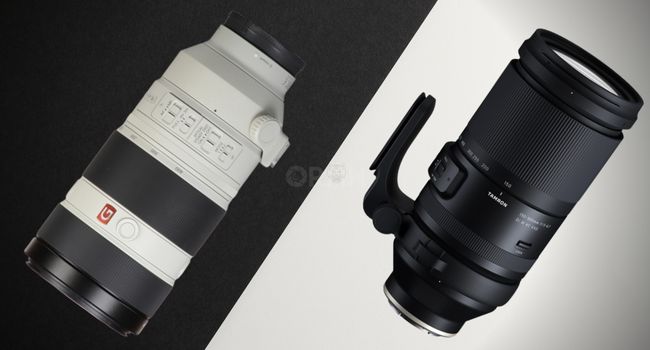
We all know the fact that lens comparisons are something that happens all the time. Now, for some people, these might be useless, but the good news is that if you are looking for something that is convenient, the right comparison might help you a lot more than you might wonder.
The comparison today revolves around Sony 100-400 vs Tamron 150-500, two very popular lenses from two very popular masters of the craft. Now, right off the bat, I am going to tell you that the Sony lens costs a lot more than the Tamron does, but they all have their strengths and weaknesses.
We are going to explore everything to the last bit.
Sony FE 100-400mm Specifications
Let’s have a look at the specs of both of the lenses. I do understand that they might look and sound identical, but there are some differences.
- Maximum aperture: f/5.6
- Minimum aperture: f/4.5.
- Weight: 1.4KG.
- Minimum focal length: 100mm.
- Weather sealed.
You can see that the specs are what you would expect from such a lens, and there is nothing wrong with what you are getting. The Sony FE 100-400mm does the job and does it really well.
Tamron 150-500mm Specifications
Tamron has been making some excellent lenses, and we are all aware of that. The Tamron 150-500mm is just as good as you would expect and delivers everything you would want from a good zoom lens. You can check out the specs below.
- Maximum aperture: f/6.7.
- Minimum aperture: f/5.0.
- Weight: 1.73KG.
- Minimum focal length: 150mm
- Weather sealed.
You can see that the lenses are a lot more similar than one might think. Sure, there are differences, but they are not as drastic as one might think.
Sony 100-400 vs Tamron 150-500: Sharpness And Stabilization Performance
Let’s start with the obvious, the Sony FE 100-400mm and the Tamron 150-500mm are both meant for long-range shooting, including sports and wildlife.
So, it is obvious that both lenses need to be sharp to the point that you are getting great results across the board, and there are no compromises.

Starting with the sharpness, I have to hand it to the Sony FE 100-400mm for delivering pictures that remain sharp across all apertures and focal lengths. Now, despite the fact that you are looking at a lens that has a maximum aperture of just f/5.6 instead of the f/6.7 on the Tamron, the results are great, and sharpness remains really, really good.
As far as the image stabilization is concerned, both lenses need to be image stabilized because, after all, how else are you taking shots that are zoomed in so much that even a slight movement throws the focus off. You do need good image stabilization in such a case, and this lens provides just that.
Sony 100-400 vs Tamron 150-500: Focus and zoom
Next up, we are going to focus on the focus and zoom of both lenses, two properties that have become a lot more common than they used to be in the older days.
Normally, if you are looking at a standard zoom lens that does not have a lot of range, things can easily be handled without any issues.
However, since we are looking into a lens that is primarily going to be used in such situations, good focus and zoom is definitely important.

Now, as far as the zoom range is concerned, the Tamron is definitely the better one because you are getting 150-500mm zoom; it is slightly higher than the Sony at the minimum zoom range, but overall, it is not bad, and it is definitely better than Sony.
Focus is another important thing that we have to look into when you are looking for a good lens, especially a zoom lens that has such a long focal length.
Thankfully, focusing on both lenses is excellent, and I doubt that you are going to run into any issues as far as that is concerned, that is for sure.
Sony 100-400 vs Tamron 150-500: Coverage And Bokeh
Moving further, we are going to start comparing both the Sony FE 100-400mm and Tamron 150-500mm. Both lenses are different in some ways, but the best thing is that if you are looking for raw performance, then you will not be let down at all.
The coverage on both lenses is a lot closer to each other. The focal length varies only slightly. However, the coverage on the Tamron 150-500mm is much, much better because you are getting better and more overage overall.
Sony, on the other hand, does not deliver the same level of coverage, so that is one thing that you need to make a note of.
Speaking of the bokeh, Sony produces better bokeh thanks to a wider aperture than the Tamron, but the difference is not something that you are going to notice unless you look really closely.
Sony also nails the bokeh thanks to the fact that it has two additional aperture blades, allowing for a better overall experience.
Sony 100-400 vs Tamron 150-500: Build and design
Moving further, we are going to compare the Sony FE 100-400mm and Tamron 150-500mm. Now, this is definitely something that is very, very important because you cannot really be without a good design, as the performance is not going to be as good as you might want in the first place.

Now, speaking of the build and design on both Tamron and Sony lenses, I am more than pleased to state that if you have been looking for something that is solid across the board and is not going to fall into pieces, then this is a great lens that you can get your hands on.
For the design, I will prefer the Sony as it is much cleaner than the Tamron, but this is just a personal preference as both lenses do look great if you are being objective.
If you really need to make a decision, then this is definitely something that is going to help you make that decision with ease. Tamron is all black, while Sony is a combination of white and black.
Sony 100-400 vs Tamron 150-500: Rings, Buttons, and switches
Of course, you are spending so much money on a lens you would want to know what sort of rings, buttons, and switches you are getting access to. Without these, your experience is not really going to go anywhere, but hey, we got you.
You get all the necessary buttons and switches that you would want, including a focus hold button, a button that lets you shift between AF and MF, as well as a switch that lets you turn off the image stabilization.
You also get a mode switch, which can be really useful. Not to forget, you also have access to a zoom ring and a focus ring; both are large, grippy, and a treat to use.
The same goes for the Tamron lens, as you get all the necessary buttons available on the lens as well as a zoom and focus ring, the lens itself feels solid, and the buttons are easily distinguishable, so if you are having issues finding the right button, it should not be a problem.
Sony 100-400 vs Tamron 150-500: Hood And Aperture
Moving further, we are going to start looking at the lens hood and the aperture of both cameras. Now, it should not come as a surprise that if you are buying an expensive zoom lens that is primarily made for all the outdoor photography activities that you have, then having a lens hood on you is important.
You would be happy to know that both lenses do ship with lens hoods, and they are what you would expect. I am not going to go ahead and nitpick about the quality here because they feel super solid and do not create any issues, either.
As far as the aperture is concerned, I have to hand it to the Sony because the minimum aperture is f/4.5, whereas the Tamron starts at f/5.0. I do understand that this is a very little difference, but this just makes Sony more versatile.
Sony 100-400 vs Tamron 150-500: Pricing And Value
I am a strong believer in the fact that the pricing is something that can make or break a lens; if it is not priced properly, you might not be able to get something that is good for you.

Speaking of the pricing, both the Sony and Tamron share a drastic price difference, which is something that might not make sense to a lot of people, but it is worth noting that the Sony lens that we have is from their G Master lineup, whereas Tamron is a standard offering.
The price alone tells us that the value lies with Tamron. Sure, the Sony offering does bring a number of perks to the table but what you are getting is simply not worth paying the premium for.
Final Verdict:
There is no denying that choosing the right lens can be a difficult ordeal when there are so many options available.
Both the Sony FE 100–400mm and Tamron 150-500mm are considered to be high-end lenses that are best in class when you are talking about their performance, but the good news is that if you are looking for something that is solid, these lenses are the way to go.
You will not be disappointed by the performance of these lenses at all, that is what we can assure you.